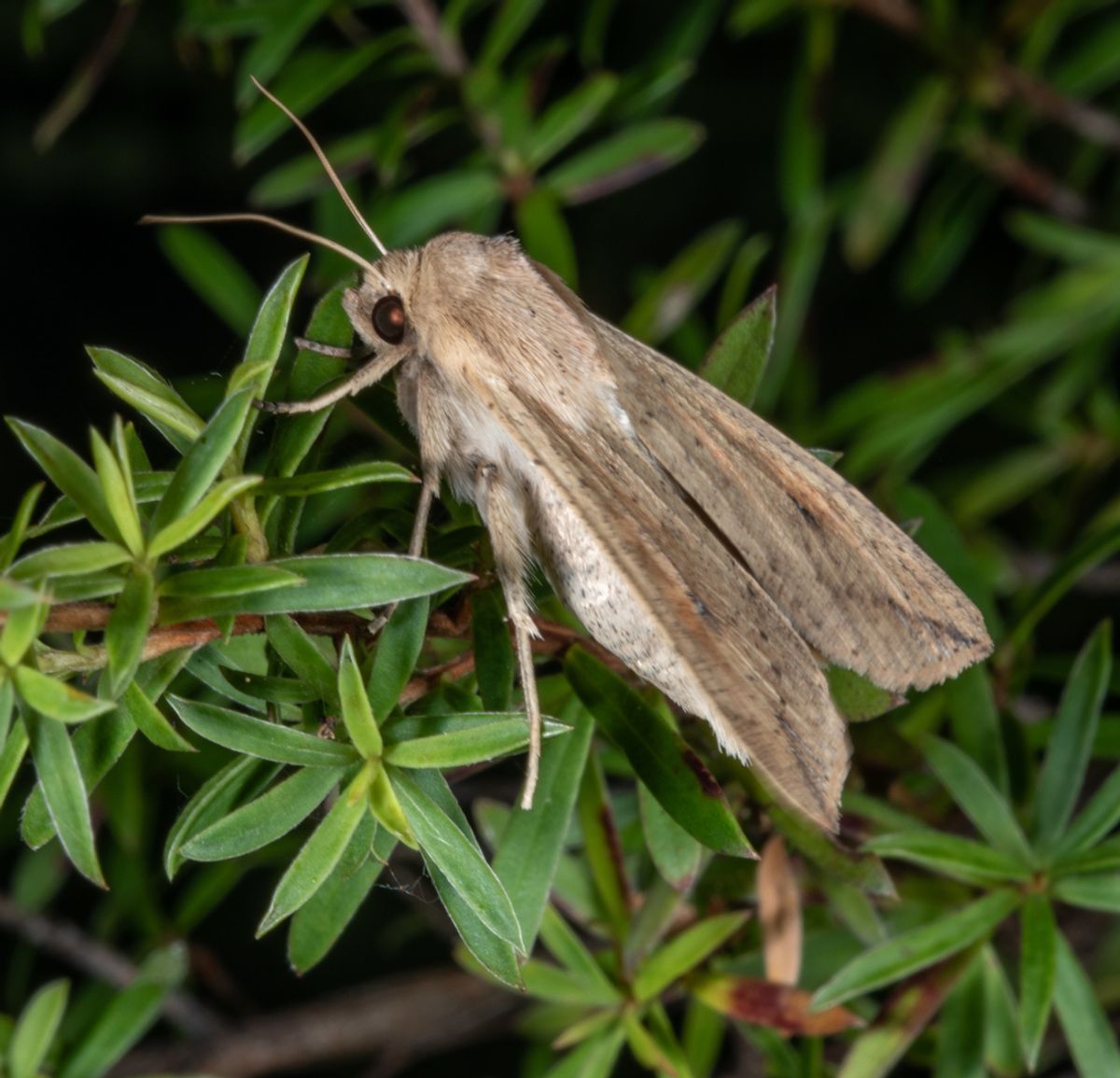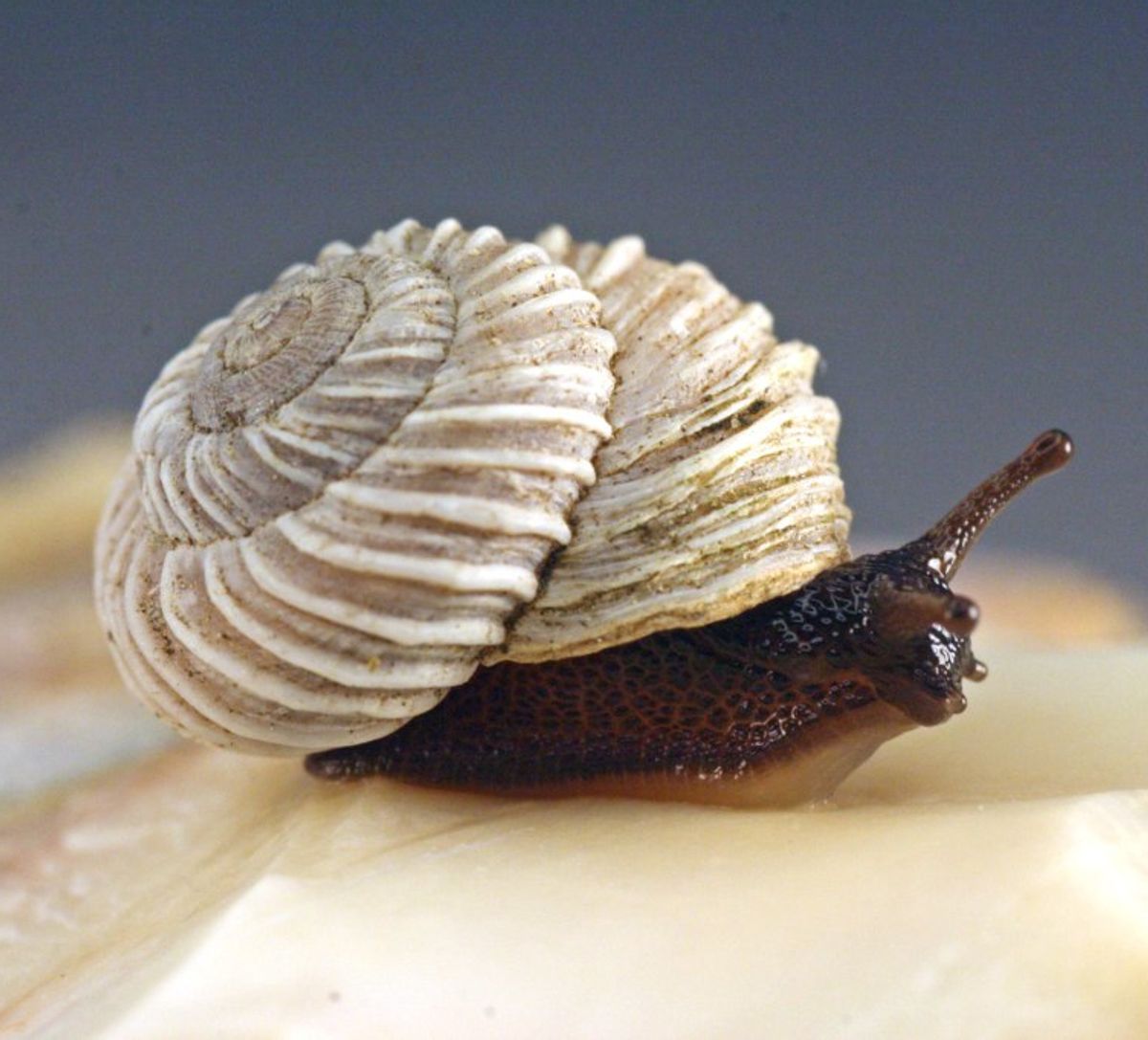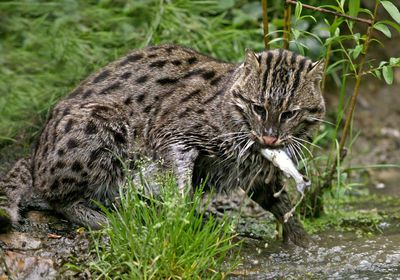ABOVE: A fishing cat living up to its name. © ISTOCK.COM, SLOWMOTIONGLI
Anyone who thinks cats hate water has clearly never met a fishing cat (Prionailurus viverrinus). These midsized (5–17 kg) South and Southeast Asian cats seem as at home in water as they are on land, capable of swimming long distances both at and below the surface. In captivity, they start playing in water as young as two months old, and when fully grown, about three-quarters of their diet comes from fish.
Unfortunately for these unique cats, the wetlands they rely on are disappearing, and many of those that remain are polluted or claimed by people, who see the cats as competitors for caught and aquacultured fishes. In one study in Thailand, for instance, 84 percent of fishing cats that were outfitted and tracked with radio collars ended up getting killed.
Because of the myriad threats facing the felines, captive breeding programs have been established around the world. And that’s what allowed scientists to notice at least one threat to the animals in captivity: cancer.
Unlike their domesticated cousins, captive fishing cats are prone to transitional cell carcinoma (TCC), a lower-urinary tract cancer. Researchers suspected that their vulnerability to the disease may have a genetic basis, as breeding populations are founded with relatively few animals and, therefore, can have low genetic diversity. But to find disease-causing genes, researchers need genomic tools—tools that now are available for fishing cats, thanks to a high-quality reference genome published as a bioRxiv preprint November 18.
The genome was assembled from PacBio HiFi reads with chromosomal arrangements determined using Hi-C chromatin capture. In all, 96.3 percent of the 2.46 Gb assembled genome was assigned to chromosomes, and a BUSCO analysis estimated the sequence is 93.5 percent complete.
Armed with a robust genome, the researchers began the search for candidate TCC-related genes in a cohort of 11 fishing cats, 5 of which had TCC. They first searched for the cat’s version of eight human genes associated with bladder cancer, observing missense variants of four of those genes in the TCC group—BRCA1, BRCA2, CHEK2, and ATM. But BRCA2 stood out, as the team found two missense variants of it in all of the TCC-afflicted animals. However, the variants were also present in half of the control cats, so the team was unable to conclude the variants are responsible for the animals’ heightened TCC risk. Additional genomic sampling, which is becoming increasingly affordable, “will help clarify causative risk variants,” the authors conclude.
The study serves as a template for using the vast knowledge accumulated for human diseases to tease apart the etiology of other animals’ conditions, the authors say, adding that findings from such comparisons could guide mating decisions and warn human caretakers of animals at particularly high risk of future disease.
And such discoveries aren’t a one-way street: Findings from animals can shed light on mysteries in human health. Other researchers have noted that feline TCC shares key similarities with the human cancer, so further research on TCC in fishing cats could, one day, lead to a deeper understanding of this cancer in people, which is responsible for around 95 percent of all bladder cancers and kills more than 15,000 people in the US each year.
Runners Up:
Northern armyworm (Mythimna separata)

Armyworm moths were given the odd moniker because they have a tendency so spread out in a line and eat their way across grassy habitats—a behavior that can make them a devastating agricultural pest in Asia and Australia. But the adults are known for something else: their long, nocturnal migrations. The moths fly up to 1,400 km each way of their journey, orienting themselves without some of the key navigation aids of day-migrating species, such as the sun and visual landmarks. Researchers have long wondered how the animals orient themselves, as well as how they fuel such arduous flights. Now, they may finally have the tools to reveal these mysteries: A Chinese research team has put together a chromosome-level reference genome for the species as well as designed an efficient gene-editing system that can tinker with that genome, according to a study published December 20 in Cell Reports. The 170.3 Gb genome, which is estimated to be 98 percent complete, was assembled from PacBio long reads, with chromosomes determined via Hi-C. The team then silenced genes believed to be involved in magnetoreception, which disrupted their ability to orient at night. The team also employed their gene editing system to explore coloration in the moths; knocking out the gene pale resulted in lighter moths, while knocking out ebony led to darker cuticles. “Successful knockout of pale and ebony not only validates their respective roles in shaping the melanization trait but also demonstrates the feasibility of a high-efficiency gene manipulation system for future functional studies and application of genetic management of this destructive pest species,” the authors write in the paper.
Costate Mountainsnail (Oreohelix idahoensis)

Calcareous rocks such as limestone and marble are essential ingredients for cement production. But people aren’t the only animals fond of suck rocks: Calcareous habitats often host diverse, specialized ecosystems. Mountainsnails in particular appear to have radiated into calcareous habitats multiple times, with numerous species now specialized for calcareous substrates. One such species in the costate Mountainsnail (Oreohelix idahoensis), which is endemic to limestone habitats in the Northwest US. To gain a better understanding of how this species adapted to its carbonate-rich environment, researchers assembled the snail’s 5.4 Gb genome from PacBio long reads and 10x Genomics linked reads. As they report December 2 in BMC Genomics, this is the largest mollusk genome assembled to date. It’s also the most repetitive, with long terminal repeats accounting for more than 57 percent of the sequences. Indeed, repeat content was estimated to be 2- to 3-fold higher in the costate Mountainsnail than in two related, non-calcareous snails. The finding “is unprecedented in molluscan genomics and sheds new light how transposable element content can vary across molluscs,” the authors write. “The genomic resources reported here will enable further studies of the genomic mechanisms underlying calcareous rock specialization and the evolution of transposable element content across molluscs.”
Genome Spotlight is a monthly column for The Scientist’s Genetics & Genomics newsletter that highlights recently published genome sequences and the mysteries of life they may reveal. |








